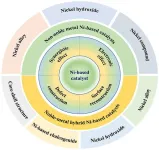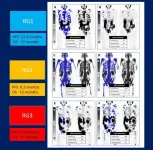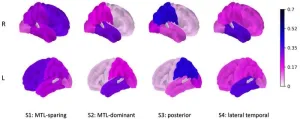(Press-News.org) ARLINGTON, Va. (June 27, 2023) — A group of five medical organizations have released updated recommendations for the prevention of methicillin-resistant Staphylococcus aureus, known as MRSA, transmission and infection. MRSA causes approximately 10% of hospital-associated infections in the United States and such infections are associated with an increased risk of death. Certain infections caused by MRSA rose by as much as 41% during the pandemic after falling in preceding years.
Strategies to Prevent Methicillin-Resistant Staphylococcus aureus Transmission and Infection in Acute Care Hospitals provides evidence-based, practical recommendations to prevent the spread of MRSA and reduce the risk of MRSA infection. The document, published today in the journal Infection Control & Hospital Epidemiology, is the most recently updated guidance in the series known collectively as the Compendium.
“The enormous strain put on healthcare during the pandemic may have contributed to the observed increase in some hospital infections. We have data that show MRSA infections rose,” said David Calfee, M.D., senior author of the updated guidance and editor of ICHE, the journal of the Society for Healthcare Epidemiology of America. “The evidence that informs these recommendations shows that we can be successful in preventing transmission and infection. We can get back to the pre-2020 rates and then do even better.”
The updated recommendations elevate antimicrobial stewardship – an effort focused on improving how antibiotics are prescribed and used – from an “additional practice” to an “essential practice,” meaning all hospitals should do it. When someone who is colonized with MRSA receives treatment with antibiotics for another infection, they may have a higher risk of developing MRSA infection and may be more likely to transmit MRSA to others. Avoiding unnecessary use of antibiotics may decrease these and other risks associated with antibiotic use, such as C. difficile infection.
The guidance describes other practices — surveillance to detect asymptomatic MRSA carriers and decolonization to eradicate or reduce the burden MRSA among people who are colonized with MRSA — for specific patient populations.
“Basic infection prevention practices, such as hand hygiene and cleaning and disinfection of the healthcare environment and equipment, remain foundational for preventing MRSA,” Calfee said. “These fundamental practices help to prevent the spread of other pathogens as well.”
The authors retained contact precautions, the use of a gown and gloves when providing care to a patient with MRSA colonization or infection, as an essential practice. However, the authors acknowledge that for a variety of reasons some hospitals have chosen to modify or may be considering modification of the use of contact precautions for all or some patients who are colonized or infected with MRSA. The updated recommendations provide guidance to help such hospitals assess risk, make informed decisions, monitor outcomes associated with changes in the use of contact precautions, and identify populations and scenarios in which continued use of contact precautions should be considered.
MRSA infection is caused by a type of staph bacteria that is resistant to many of the antibiotics used to treat ordinary staph infections. Healthcare-associated MRSA infections often follow invasive procedures, such as surgeries, or the use of devices, such as central venous catheters, and can be spread within hospitals by the hands of health care personnel or through contact with contaminated surfaces and equipment.
The guidance updates the 2014 Strategies to Prevent Methicillin-Resistant Staphylococcus aureus Transmission and Infection in Acute Care Hospitals. The Compendium, first published in 2008, is sponsored by the Society for Healthcare Epidemiology (SHEA). It is the product of a collaborative effort led by SHEA, with the Infectious Diseases Society of America, the Association for Professionals in Infection Control and Epidemiology, the American Hospital Association, and The Joint Commission, with major contributions from representatives of several organizations and societies with content expertise. The Compendium is a multiyear, highly collaborative guidance-writing effort by over 100 experts from around the world.
In coming weeks, a new Compendium section will be published outlining approaches to implementation of infection prevention strategies, followed by an update to strategies to prevent catheter-associated urinary tract infections.
Recently published Compendium updates include strategies for preventing surgical site infections, central line-associated bloodstream infections, ventilator and non-ventilator associated pneumonia and events, C. difficile infection, and strategies to prevent healthcare-associated infections through hand hygiene.
Each Compendium article contains infection prevention strategies, performance measures, and approaches to implementation. Compendium recommendations are derived from a synthesis of systematic literature review, evaluation of the evidence, practical and implementation-based considerations, and expert consensus.
###
About Infection Control & Hospital Epidemiology
Published through a partnership between the Society for Healthcare Epidemiology of America and Cambridge University Press, Infection Control & Hospital Epidemiology provides original, peer-reviewed scientific articles for anyone involved with an infection control or epidemiology program in a hospital or healthcare facility. ICHE is ranked 24th out of 94 Infectious Disease Journals in the latest Web of Knowledge Journal Citation Reports from Thomson Reuters.
About the Society for Healthcare Epidemiology of America (SHEA)
The Society for Healthcare Epidemiology of America (SHEA) is a professional society representing more than 2,000 physicians and other healthcare professionals around the world who possess expertise and passion for healthcare epidemiology, infection prevention, and antimicrobial stewardship. The society’s work improves public health by establishing infection-prevention measures and supporting antibiotic stewardship among healthcare providers, hospitals, and health systems. This is accomplished by leading research studies, translating research into clinical practice, developing evidence-based policies, optimizing antibiotic stewardship, and advancing the field of healthcare epidemiology. SHEA and its members strive to improve patient outcomes and create a safer, healthier future for all. Visit SHEA online at shea-online.org, facebook.com/SHEApreventingHAIs and twitter.com/SHEA_Epi.
END
Computer scientists at the University of Waterloo have discovered a method of attack that can successfully bypass voice authentication security systems with up to a 99% success rate after only six tries.
Voice authentication – which allows companies to verify the identity of their clients via a supposedly unique “voiceprint” – has increasingly been used in remote banking, call centers and other security-critical scenarios.
“When enrolling in voice authentication, ...
Prof. Okujima, in collaboration with Prof. Kobayashi at Shinshu University, reported the synthesis, molecular structure, optical properties and electronic structure of unusual phenanthrene-fused porphyrins.
Precursor porphyrins fused with aryl-substituted bicyclo[2.2.2]octadiene afforded the corresponding arylbenzoporphyrins (arylBPs) by retro Diels–Alder reaction. Unusual phenanthroporphyrins were obtained via the intramolecular Scholl reaction of arylBPs. We analyzed the optical and electronic structures using magnetic circular dichroism spectroscopy and time-dependent density functional theory calculations.
Our ...
The study is led by Ligang Feng (School of Chemistry and Chemical Engineering, Yangzhou University).
The rapid development of the economy driven by the large consummation of traditional fossil fuels is not sustainable, and global attention is shifted to the utilization of renewable energy sources, and biomass fuels. Methanol is considered a good biomass fuel to realize energy storage and conversion, which is convenient for storage and transportation; more importantly, it is much safer than other fuels such as gasoline, diesel, and natural gas. In addition, it can be prepared with wide sources in low-cost and ...
Diamond has long been the go-to material for quantum sensing due to its coherent nitrogen-vacancy centres, controllable spin, sensitivity to magnetic fields, and ability to be used at room temperature. With such a suitable material so easy to fabricate and scale, there’s been little interest in exploring diamond alternatives. But this GOAT of the quantum world has one Achilles Heel… It’s too big. Just as an NFL linebacker is not the best sportsperson to ride in the Kentucky Derby, diamond is not an ideal material when exploring quantum sensors and information processing. ...
Chicago, Illinois (Embargoed until 3:45 p.m. CDT, Tuesday, June 27, 2023)—By monitoring early-response biomarkers in men undergoing 177Lu-PSMA prostate cancer treatment, physicians can personalize dosing intervals, significantly improving patient outcomes. In a study presented at the Society of Nuclear Medicine and Molecular Imaging 2023 Annual Meeting, early stratification with 177Lu-SPECT/CT allowed men responding to treatment to take a “treatment holiday” and allowed those not responding the option to switch to another treatment.
Approved by the U.S. Food ...
Chicago, Illinois (Embargoed until 4:05 p.m. CDT, Tuesday, June 27, 2023)—A new computational technique that combines genomic and tau PET imaging data promises a more personalized approach for subtyping Alzheimer’s disease. Based on a novel clustering framework using sparse canonical correlation analysis (SCCA), the integrated approach was successful in identifying four subtypes of Alzheimer’s disease and the top genes associated with each. This research was presented at the 2023 Society of Nuclear Medicine and Molecular Imaging Annual ...
From the 20-foot-long jawbones of the filter-feeding blue whale to the short, but bone-crushing, jaws of the hyena and the delicate chin bones of a human, the pair of lower jawbones characteristic of mammals have evolved with amazing variation.
But at first glance, having a single bone on each side of the head — which creates a stiff lower jaw, or mandible — doesn't appear to give mammals an advantage over other vertebrates, which have at least two and as many as 11 bones comprising each side of the lower jaw.
Crocodiles, for example, have an edge over hyenas when it comes to their bite strength relative to ...
MIAMI, FLORIDA (June 27, 2023) – Cancer patients with unmet supportive care needs are more likely to experience worse clinical outcomes, including more emergency department (ED) visits and hospitalizations, according to new research from Sylvester Comprehensive Cancer Center at the University of Miami Miller School of Medicine.
The study, published June 21 in JAMA Network Open, also found that Black race, Hispanic ethnicity and factors such as anxiety, depression, pain, poor physical function and low health-related quality-of-life ...
CHAPEL HILL, N.C. – Diabetes is a progressive disease that affects one’s ability to control blood sugar levels. For many patients, the condition becomes more severe over time and blood sugar levels grow more difficult to manage. Glucagon-like peptide-1 (GLP-1) receptor agonists, such as semaglutide, have granted patients more control in lowering of blood sugar.
John Buse, MD, PhD, the Verne S. Caviness Distinguished Professor of Medicine in the Division of Endocrinology and Metabolism, and an international team of researchers have presented new findings about new higher-dose formulations ...
The age of those who are distressed because of a mismatch between their biological sex and their gender identity—known as gender dysphoria—has been steadily falling, reveals research published in the open access journal General Psychiatry.
And it’s lower for those assigned female sex at birth than those assigned male, the findings indicate.
Recent studies suggest that gender dysphoria is becoming more common, particularly among those assigned female sex at birth. But these studies have been hampered by small sample sizes, short monitoring periods, or outdated datasets.
In a bid to get round these limitations, the researchers drew on data submitted ...







